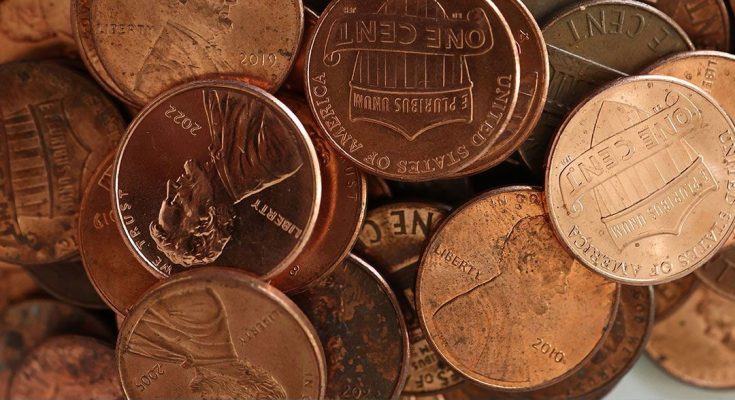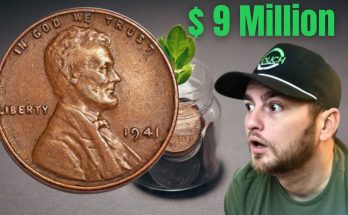Start saving your pennies, folks! Because soon you won’t be getting any more of them. The U.S. Treasury just announced it will be stopping production of the humble one-cent coin. Honestly, it’s time. A whopping 42% of American adults want the penny gone, and we literally throw away $68 million in coins every year. (Yes, in the trash.)
Still, it’s hard not to feel a little sentimental watching those copper coins roll off into the sunset. As someone who grew up buying bags of penny candy (yes, I’m old), it feels like the end of an era. On the bright side: no more digging through your car console for exact change, and no more awkward coin math at the register. On the downside: no more lucky pennies on the sidewalk, no more coins for fountains, and are we just supposed to leave the penny loafers empty? Also, Levi’s, what’s the plan for that tiny pocket?
“While it is strange to see something that we’ve known our whole lives disappearing, it’s fun to see this happening in real time because it’s bringing more awareness to not just coin collecting but also how currency evolves,” says numismatist Neal Paul, a certified expert in rare coins and a professional coin collector. “Coin collecting is so accessible—everyone has pennies. It’s worth checking yours to see if you’ve got something valuable now or something that could be worth big bucks in the future.”
Whether you’re feeling nostalgic or just thrilled to carry less jingling metal, consider this: That dusty coin jar in your kitchen might actually be your retirement plan. Some of those soon-to-be-extinct pennies could rake in serious cash by 2050. We’re talking “laughing from your beachfront property in Boca” kind of money. So grab a magnifying glass. Paul is walking us through what happens to pennies now and which ones could turn you into a millionaire—one cent at a time.
Get Reader’s Digest’s Read Up newsletter for more knowledge, humor, cleaning, travel, tech and fun facts all week long.
What will happen to all the pennies in circulation?
Short answer: nothing dramatic, Paul says. They’re not being banned, and the government isn’t going to come knocking on your door like a reverse Tooth Fairy, demanding your pennies. They’ll still be legal tender for the foreseeable future, so stores and banks can still accept them, vending machines will still ignore them, and your grandpa will continue handing them out like they’re made of gold.
Historically, when coins get the boot (RIP half-cent, 1857), they tend to stay in circulation for a few decades before fading into obscurity (or the junk drawer), Paul explains. So expect that most of your pennies will end up where they’ve always gone—jars, couch cushions, the backseat of your car or in your toddler’s tummy (after which they’ll come out the other end extra shiny!).
“This certainly isn’t the first time the Treasury has discontinued a coin—we’ve had some really strange coins in our history—and it won’t be the last time either,” Paul says. “In fact, the nickel will likely soon be discontinued as well. It costs 12 cents to make a 5-cent nickel, so it costs more than it’s worth. [Plus], we’re moving toward a more digital currency.”
Fun fact: The U.S. doesn’t actually have a “penny.” Wait, what? “Our currency has always officially been called the ‘cent’ because it is 1% of a dollar,” Paul explains. “England has the ‘penny,’ and us using it as a nickname is a holdover from the days we were ruled by Britain.”
Will all pennies become rare and valuable once they’re no longer produced?
Probably not, but some certainly will. While it’s true that a limited supply usually means big bucks, pennies won’t be “rare” for a long time, since there are currently more than 114 billion pennies in circulation. Yes, billion with a b. That’s roughly 426 pennies per person in the U.S. This means that most pennies will remain worth what they’ve always been: 1 cent. However, there are some special pennies you’ll want to keep an eye out for.
Which pennies have the best shot at raking in big bucks?

If you’re hoping to cash in by 2050, now’s the time to sort through your stash of coins. The most promising pennies aren’t the ancient, rare collector’s items (we’ll get to those in a minute) but the ones hiding right now in plain sight, in everyday circulation.
“Everyone’s looking for rarities, but they don’t have to be the crown jewels to be worth collecting,” Paul says. “Overall, coins are a good investment because they hold their value over time.”
Here are five common(ish) pennies that could pay off big later:
-
Indian Head Penny: These were minted only from 1859 to 1909, and some years are more valuable than others. They’re typically worth $1 to $200, but very rare varieties in good condition can fetch thousands.
-
1943 Steel Penny: Due to conserving copper for World War II, these pennies were minted using zinc-coated steel instead of copper. They’re worth between $1 and $3,000, depending on type and condition.
-
1857 Flying Eagle Penny: Pennies were 100% copper up until 1858, so any pennies made before this year are worth more than face value. The 1857 pennies are worth about $30 to $250, though some sell in the thousands.
-
1943 Copper Penny: These were accidentally minted in copper during the transition to zinc-plated steel in 1943 and are far more valuable than even their older copper counterparts. They sell today for thousands to tens of thousands of dollars.
-
1972 Double Die Obverse Penny: Double-die errors occur when a coin is struck twice in the same die, creating a doubled impression, and make any coin more valuable. In this case, look for ghost-like shadows on “LIBERTY” or the date. This one already goes for $100 to $650 and will definitely increase in value over the next 25 years.
How long will it take for these pennies to go up in value?
No one can say for sure, as coin value depends on a lot of factors in addition to rarity, so patience is the name of the coin-collecting game, Paul says. That said, the “penny boom” probably won’t kick into high gear until around 2050—when the last of the coins start to dry up and collectors feel the full sting of nostalgia. So think of it less of a “get rich quick” scheme and more of a “get rich eventually while doing nothing except hoarding loose change” scheme.
Side note: Expect to see your grocery bill increase immediately, though. Without the penny, the U.S. Treasury has instructed people to round prices to the nearest nickel (5 cents). They say that businesses can round up or down, but let’s be realistic—who is going to choose to round down?
How much more will the already-valuable pennies be worth in 2050?

For the superstars of the penny world—the ones already trading hands for serious cash—expect their value to skyrocket over the next few decades. “I owned a 1909-S VDB Penny, worth nearly $6,000,” Paul says, adding that he ended up trading it for two other rare coins. “It was well worth it,” he says.
Here are a few VIP pennies:
-
1943-D Lincoln Bronze Wheat Penny: Only a few dozen exist, made by mistake during wartime metal shortages. They’re currently worth $400,000 to $900,000, depending on condition, but one recently sold for $1.7 million. By 2050? The price tag could top $2 million.
-
1909-S VDB Penny: This rare coin bears the initials of designer Victor D. Brenner. Right now, it can fetch $700 to $2,000, and pristine versions go for $10,000 or more. Expect steady growth.
-
1955 Double Die Penny: This is an iconic error coin—easy to spot, hard to find. These pennies are already worth $1,500 to $5,000, with one selling for $7,800, so double or triple that in 25 years wouldn’t be surprising.
-
1877 Indian Head Penny: This is one of the rarest of the Indian Head series. Current price tag? Around $500 to $5,000, but the most valuable sold for $149,500. Expect collectors to pay top dollar for top quality in the future.
-
1922 No D Penny: This Denver Mint coin forgot to stamp the “D.” Oops. More common types are already fetching $700 to $2,000, while the rarest variety sold for $57,500. These values will only go up.
Is there an easy way to find these pennies in your coin stash?
It’s not glamorous work, but it’s not hard to do. Paul offers these pro tips for spotting valuable pennies:
-
Use a bright light.
-
Look at pennies with a magnifying glass or your phone’s zoom camera.
-
Check dates first, focusing on anything pre-1982 (when pennies were still mostly copper).
-
Look for mint marks like “S” (San Francisco) or design quirks like double lettering or off-center prints.
-
Use a coin guide or trusted website to compare photos.
What should you do with these pennies if you find them?
“If you’ve got one, there’s always someone looking to buy. The coin industry is very lucrative right now,” Paul says, adding that at a recent conference, he watched a professional collector spend more than $2 million in two days on rare coins.
So it’s definitely worth it to take care of yours. How? For starters, don’t spend these rare pennies or exchange them at the bank. Make sure you’re storing them safely, using coin holders or airtight bags—humidity is not your friend, he says. Next, get the coins in question authenticated by a reputable coin dealer or grading service (like PCGS or NGC). Once they’re authenticated, you can choose to save them and keep an eye on the market. When or if you decide to sell, you have three options: auction (Heritage Auctions and Stack’s Bowers are top choices), sell to a collector (often faster but possibly for less than auction value) or contact a rare-coin broker (they’ll take a cut, but it’s hassle-free).
One more idea? Forget about the money, frame one and hang it on your wall—just for the bragging rights. “It’s a piece of history you can literally hold,” Paul says. “How cool is that?”
RELATED:
- Here’s How Much You Need in Your Savings Account to Retire in Every State
- New Report: This Is the Best Place to Retire in the U.S. If You’re Short on Cash
- This One Common Habit Could Be Depleting Your Retirement Savings—Just Before You Really Need the Cash
About the expert
|
Why trust us
At Reader’s Digest, we’re committed to producing high-quality content by writers with expertise and experience in their field in consultation with relevant, qualified experts. We rely on reputable primary sources, including government and professional organizations and academic institutions as well as our writers’ personal experiences where appropriate. We verify all facts and data, back them with credible sourcing and revisit them over time to ensure they remain accurate and up to date. Read more about our team, our contributors and our editorial policies.
Sources:
- Neal Paul, numismatist, certified expert in rare coins and professional coin collector; phone interview, May 28, 2025
- Wall Street Journal: “Americans Throw Away Up to $68 Million in Coins a Year. Here Is Where It All Ends Up”
- YouGov: “More Americans want to drop the penny than to save it”
- Axios: “What killing the penny means for you”
- U.S. Mint: “Penny”
- Professional Coin Grading Service (PCGS)



